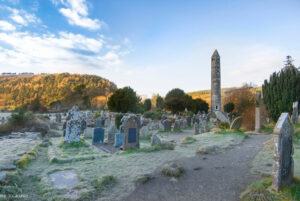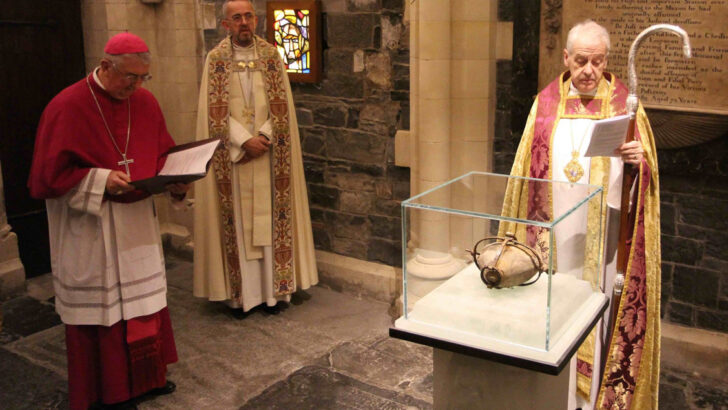It is instructive when looking back in history to ask whose memory endures. Is it that of a distinguished writer, a captain of trade and commerce, a statesman, a warlord, a political leader?
When one looks back in Dublin’s history it is clearly not one of these at all, but rather it is that of St Laurence O’Toole (1128-1180), Archbishop of Dublin, whose feast day was celebrated recently.
Those readers who think that writing modern biographies is a controversial matter are right; it certainly is, but not as fraught as writing about a medieval biography. It is not so much a matter of rewriting the past, but of writing about it at all.
The 800th anniversary of the canonisation of St Laurence O’Toole falls in May 2025. He is one character from medieval Irish history crying out for a proper scientific biography. Perhaps a young historian, with that anniversary in mind, has such a book in hand. But I have doubts about that. A brief account of his career as generally received will illustrate the difficulties.
Born in 1128 Laurence O’Toole sprung from two princely families of those parts of Leinster now known as Counties Kildare and Wicklow. His mother was an O’Byrne. When only ten years old he became a victim of one of the internecine conflicts waged by Irish chieftains in that period.
Hostage
Dermot MacMurrogh, King of Leinster, attacked the O’Toole territory and carried off Laurence whom he held as a hostage. After two years Laurence was released into the custody of the Abbot of Glendalough. At the famous monastic centre, he was, it seems, a keen student, and decided to join the community and was ordained in his early 20s.
When the Abbot of Glendalough died in 1157, Laurence succeeded him. His appointment at such a young age indicated the high regard in which he was held by his contemporaries. Those who nowadays visit the extensive ruins of Glendalough are left in no doubt as to the importance of that foundation.

It was as large as a town. Besides being a place for worship and prayer, it was a famous educational centre. In addition, it concerned itself with the care of the sick, the infirm and the otherwise vulnerable members of the society of those times. Chroniclers attest to the competence and dedication with which Laurence presided over the manifold activities associated with that great ecclesiastical centre.
Presumably not least because of his success as abbot, Laurence was appointed to succeed Gregory, Dublin’s first archbishop, in 1162. His time as archbishop coincided with a very difficult period in our history.
The Norman invasion generated a great deal of conflict, on the one hand, between the Normans and the Gaelic chieftains and, on the other, warfare between Gaelic chieftains prompted by that invasion. Initially as the new archbishop of Dublin, he attempted unsuccessfully to persuade the Irish kings and chieftains to present a united front to the Norman incursion.
Thereafter he was indefatigable in his efforts to achieve peace and to avert the tragic effects of the conflict. By his exemplary life, forthright preaching and wise administration he greatly improved the Christian quality of the lives of the priests and people of his archdiocese.
According to a contemporary account he infused into his priests a new enthusiasm for the recitation of the Divine Office in choir, inculcated in them a sense of mystery in the celebration of Mass and restored the reverence due to altars and churches.
From our perspective, perhaps the most serious problem faced by Laurence O’Toole was that of lay-investiture. This was a problem which affected the Christian Church throughout the known world of that time. To understand it, it is as well to recall the nature of society then.
Egalitarianism
People today are generally committed to egalitarianism, at least in principle, and become impatient at overt signs of class-consciousness. Such divisions as exist in our community are as nothing when compared to the structures of society in Ireland of the 12th Century.
Then there were two classes, the princely families and the serfs. The former owned everything, controlled everything, the latter accounted for little or nothing. Besides controlling secular affairs the princely families also had great influence in ecclesiastical matters.
They claimed and in many places exercised the right to invest or appoint bishops, abbots, parish priests and superiors to convents and other religious institutions.
As can be imagined, not all those so appointed were suitable and constituted a serious stumbling-block to the Church’s mission. Laurence addressed the problem with tact, determination and, it appears, with considerable success.
Lay-investiture was on the agenda of the reforming Third Lateran Council held in 1179. Laurence was one of the six prelates who represented the Church in Ireland at the council. He was appointed Papal Legate to supervise the implementation of the reforms in Ireland.
On his return home he presided over the convocation of clergy at Clonfert at which “it was laid down by a constitution that no laymen should have the rule of any Church matters thenceforth”.
In 1180 Ireland was once again the scene of much conflict between the Normans and the Irish chieftains. Laurence was eager to meet Henry II in an attempt to have peace restored. The king, who had been greatly offended by Laurence’s exertions to curtail lay-investiture, was not willing to meet him. Laurence, however, was not to be denied.
He travelled to Normandy to urge his peace proposals on the king. At Eu, 20 miles from Dieppe, he became ill and died some days later in the nearby Augustinian Abbey on November 14, 1180.
In 1226, less than 100 years after his birth, Laurence O’Toole was canonised. His tomb can be seen in the crypt of the parish church at Eu. His heart, enclosed in an iron casket, was brought back to Dublin and rests in a place of honour in Christ Church Cathedral.
Dubliners take a special pride in Laurence O’Toole who remains a living memory and a symbol of the city’s Christian heritage. His service as archbishop is to be remembered especially for the courage and probity with which he faced the great issues of his time.
Divided
St Laurence O’Toole stands in history as a man in a troubled and divided time. He came from a Gaelic culture in decline, and laboured as a cleric in a new diocese in the hands of the invasive and ambitious Normans, and he had to deal with an unusual ruler King Henry II, a monarch more engaged at the time with the Angevin Empire in Europe.
The Church and St Laurence faced many problems. Today the problems associated with the achievement of justice and peace and the avoidance of violence are with us as before. And as one can see from the discussions and deliberations at the Synod in Rome, one of the great ongoing debates throughout Christendom is the role of the laity in the institutional Church.
As demonstrated in the life of Laurence O’Toole, these issues can and must be solved by the principles of justice and charity. In attempting their solution it would be wise also to take account of the experience acquired by the Church in wrestling with such problems for almost two millennia.
However, finding a solution to present day problems may be helped by a better and more inquiring examination of the past, and that is what we hope to get from historians.
St Laurence O’Toole anniversary
The Archbishop of Rouen has invited the Archbishop of Dublin and the people of the Dublin Diocese to join him in the town of Eu in Normandy in May 2025 for the celebration of the 800th anniversary of St Laurence O’Toole’s canonisation with the Diocese of Rouen.
Those interested in participating in, or organising a group for, this pilgrimage celebration, can contact Fr Ivan Tonge, Ringsend (ivan.tonge@gmail.com), or Fr John Flaherty, Portmarnock (john.flaherty@dublindiocese.ie), so that the planning can be advanced. This visit to Normandy will be co-ordinated by Marian Pilgrimages.


 Back in 2012 the shrine containing the relic of St Laurence O’Toole’s heart was stolen from Christ Church Cathedral. When it was eventually returned by the police, having been found in the Phoenix Park after a tipoff, it was installed in a newly designed shrine in the cathedral, which was dedicated in an ecumenical service by the Archbishop of Dublin on November 14, 2018, the saint’s feast day. Pictured are Church of Ireland Archbishop Michael Jackson (right) with Archbishop Diarmaid Martin (left) and Dean David Dunne at the dedication ceremony.
Back in 2012 the shrine containing the relic of St Laurence O’Toole’s heart was stolen from Christ Church Cathedral. When it was eventually returned by the police, having been found in the Phoenix Park after a tipoff, it was installed in a newly designed shrine in the cathedral, which was dedicated in an ecumenical service by the Archbishop of Dublin on November 14, 2018, the saint’s feast day. Pictured are Church of Ireland Archbishop Michael Jackson (right) with Archbishop Diarmaid Martin (left) and Dean David Dunne at the dedication ceremony. 